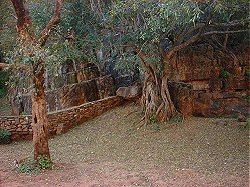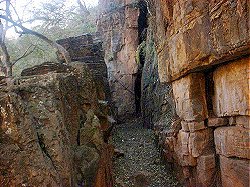Echo Caves
Useful Information

| Location: |
Echo Caves, Farm Klipfonteinhoek, Ohrigstad, 1122.
At the top of the Molopong Valley in Mpumalanga. 26 km from Ohrigstad, on the road to Abel Erasmus Pass. From Gauteng N4 towards Nelspruit, at Belfast turn left then right onto R540 to Lydenburg, R36 to Ohrigstad. After Ohrigstad and Draasloot turn left. (-24.562408, 30.603178) |
| Open: |
All year daily 8:30-16:30. [2024] |
| Fee: |
Adults ZAR 85, Children (13-18) ZAR 55, Children (5-12) ZAR 35, Children (0-4) free, Seniors ZAR 60. [2024] |
| Classification: |
 Karst Cave Karst Cave
|
| Light: |
 Incandescent Incandescent
|
| Dimension: | |
| Guided tours: | L=800 m, D=45-60 min, Largest chamber: L=100 m, H=40 m. |
| Photography: | allowed |
| Accessibility: | no |
| Bibliography: | |
| Address: |
Echo Caves, Farm Klipfonteinhoek, Ohrigstad, 1122, Tel: +27-13-238-0015, Tel: +27-64-809-9898.
E-mail: Postal address: Echo Caves, PO Box 34, Ohrigstad, 1122. |
| As far as we know this information was accurate when it was published (see years in brackets), but may have changed since then. Please check rates and details directly with the companies in question if you need more recent info. |
|
History
| 1923 | discovered by the owner of the Klipfonteinhoek farm. |
| 1959 | opened to the public. |
| 1980s | additional caves included in the tours. |
| 2023 | the owner and operator Anneke Claassen brutally murdered. |
Description

Echo Caves was discovered by the owner of the Klipfonteinhoek farm who was searching for water in 1923. He found the cave and was quite surprised, when he realised that some of his cattle had already discovered the cave before him. The animals went obviously unattended into the cave to drink.
But of course he was not the first to discover it, the cave contained numerous archaeological remains, implements and tools from the Middle and Late Stone Age. They also say there were remains of the early Iron Age. While there are remains of iron smelting in central Africa from 2000 BC, the massive use of iron and thus the Iron Age started around 200 in west Africa, invented by the Bantu, who then spread all over Africa. They reached South Africa between 300 and 400, so that’s the time frame of the Iron Age remains. Today the Bantu are an important part of the South African inhabitants. So the cave has been known for hundreds or thousands of years by the locals. Many of the findings are on display in the museum near the cave entrance which is called Museum of Man. The cave was declared a National Monument.
The cave was opened to the public in 1959. It was developed after the construction of the Abel Erasmus Pass and the Strijdom Tunnel nearby. The new road caused an increase of travellers to this area, which made this tourist venture possible. Today the cave is located in an area of great tourist interest in the northern region of the Drakensberg range. There is the Panorama Route along the Blyde River Canyon and the Great Escarpment with God’s Window viewpoint. The best time to travel this area is the dry winter months (JUN to AUG) because the escarpment forms a barrier for the clouds bringing a lot of mist and rain. But despite its location, this cave is not on the major tourist routes, especially it is not on the schedule of tour operators. As a result, it is much less frequented and the visit is more tranquil.
Once the local people used one of the stalactites as a drum to warn of approaching Swazi. The caves, extending for some 40 km, were transporting the sound for very long distances. As a result, the people were warned and took refuge in the cave.
There are numerous legends about the cave, this one is explaining the name. A funny story, but typical for stories about mysterious caves, it is also quite fantastic. The cave is not 40 km long, sound does not travel over long distances underground, and nobody has been able to reproduce this acoustic experiment. However, stalactites produce sound when hit, and there is such a stalactite which is close enough to the surface to be heard outside.
Another legend is even weirder. It tells about men with long white robes, who came in search of gold and to trade with the indigenous people. We have no idea what the timeframe is, what people wear white robes, and how much of the legend is based on real history.
The most spectacular chamber of the cave is called Madonna Chamber, named after a pilar, which resembles a statue of Madonna. A wall covered by flowstone is called the frozen waterfall. The following passage is sometimes flooded by a cave river, when the water rises after heavy rains. The next chamber is called Elephant Chamber, again after a stalactite, which resembles the big ears and trunk of an African elephant, and the dolomite rock of the roof looks like the skin of the elephant. The next two chambers were also named after formations, the Crocodile Chamber after flowstone looking like a crocodile, and Samson’s Chamber after a numerous pillars which look like the columns of the temple which Samson destroyed in the story from the Bible. The last chamber, Crystal Palace Chamber, is again named after the speleothems, numerous stalactites and stalagmites.
The cave also offers cave trekking tours after appointment for small groups. There are hotel rooms, self-catering units, and a youth hostel with decent prices. On site are also a restaurant and a curio shop, which are open with the show cave.
A strange murder happened on 03-JUN-2023, when Anneke Claassen, 73, and her friend Hennie Claassen, 77, were murdered. Despite having the same surname, they were actually not related. Anneke Claassen was the owner of the hotel and of Echo Caves. Workers on the property noticed that the house of Hennie Claassen was on fire, employees and tour guides managed to access the house. They found him still alive, but he died a little later. Then they checked the house of Anneke Claassen, which is 120 m away, and was also burning. When they finally gained access, she was already dead. It seems they were both murdered by a former employee who tried to rob them. He tried to open the safe but failed, but he tortured them and set them on fire while still alive using carpets, rugs, bedding and newspapers to light the fire. The murderer was arrested a few weeks later. According to the wikipedia page, there was some discussion about the future of the show cave, after the death of the owner. But as far as we understand, it is still open under new management.
 Search DuckDuckGo for "Echo Caves"
Search DuckDuckGo for "Echo Caves" Google Earth Placemark
Google Earth Placemark Echo Caves - Wikipedia (visited: 12-MAR-2024)
Echo Caves - Wikipedia (visited: 12-MAR-2024) Echo Caves, official website (visited: 25-NOV-2021)
Echo Caves, official website (visited: 25-NOV-2021) Index
Index Topics
Topics Hierarchical
Hierarchical Countries
Countries Maps
Maps